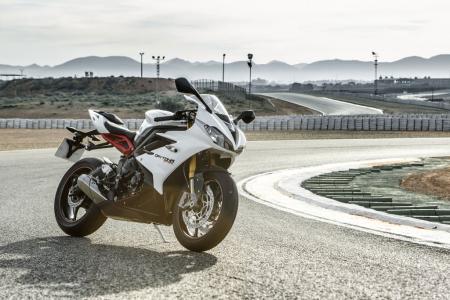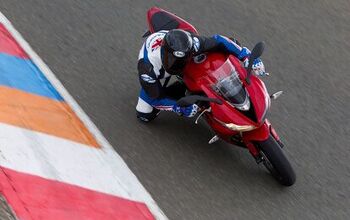2013 Triumph Daytona 675R Review - Motorcycle.com
I’m throwing journalistic objectivity aside for a moment to say I love the Triumph Daytona 675. It’s a sentiment my fellow Motorcycle.com cohorts share as well. What’s not to love about its intoxicating engine and nimble handling? Throw into the mix the up-spec R model with its Ohlins suspension, Brembo brakes and quickshifter and we can’t stop waxing poetic about it.
So when we learned the 2013 Triumph Daytona 675 and 675R would be all-new motorcycles, finally getting a substantial revamp since its 2006 introduction and 2009 update, we wondered how the boys in Hinckley would one-up themselves. Answer: more power!
New This, New That
To accommodate the larger bore yet keep the same overall physical size of the engine, it utilizes a sleeveless cylinder design with Nikasil-coated bores for reduced friction. The cylinder block is now separate from the crankcase.
Compression is up to 13.0:1 from 12.65:1. Each piston pin is nitride coated for strength, with the big end bearing growing to 35mm from 33mm. Likewise, the lower crankcase is redesigned to reduce power loss due to oil drag, and its main bearings are upgraded—all measures to help cope with the increased power.
Each cylinder is fed fuel via two fuel injectors, a first for Triumph. New titanium intake valves are the same 30.5mm diameter as before, but stem length is increased half a millimeter to 4.5mm. Its shape is also revised with more material to create a more dome-like appearance Triumph says improves flow.
Exhaust valves remain steel bits, but diameter is reduced from 25.5mm to 24.2mm, thereby reducing weight slightly. All told, the new valvetrain weighs 17% less than before. Camshafts are also new, with increased lift.
The transmission receives a slew of updates for smoother, more precise engagement, especially between the first two gears, a critique noted from Triumph’s race teams. A slip-assist clutch reduces lever effort by 25% compared to last year and keeps the rear wheel in check, enlisting the help of the ECU to open throttle butterflies if needed. Finally, the 15-tooth countershaft sprocket is down a tooth from last year for improved acceleration.
What does all this add up to? Triumph says max power at the crank is increased 3 horses and torque up 1.5 ft.-lbs. to 126 hp and 55 ft.-lbs., respectively, compared to the old bike. More importantly, graph overlays provided by Triumph indicate the new mill has a stronger midrange and healthier top-end.
A new subframe provides a narrower profile but is also responsible for the 10mm decrease in seat height in the standard 675 (32.3 in. vs. 32.7 in.). The new swingarm retains its adjustable pivot point for racing but is slightly shorter for quicker handling.
KYB fully-adjustable suspension bits adorn both ends of the standard model, while top-shelf Ohlins NIX30 forks and TTX36 shock compliment the R variant. Because of the new exhaust layout, damping rates for both models are slightly different than before to account for the weight loss at the rear of the bike. However, the 10mm longer suspension travel is responsible for the 675R retaining its tall seat height from last year.
Nissin and Brembo are the two brake choices for 2013. Both provide four-pot monobloc calipers, though the standard gets the Japanese brand, R models the Italian. The 310mm discs are 4.5mm thick, up 2mm and 0.5mm, respectively.
All bikes coming stateside will have switchable ABS, with a special “Circuit” mode which still allows stoppies and rear-wheel drifts into corners. The system works by monitoring each wheel both independently and in relation to each other. It measures the rate of deceleration for each wheel and will activate rear ABS when its speed is more than 40% slower than the front.
Front ABS will intervene if the ECU reads a rate of deceleration not humanly possible, like panic braking in grass (commonly done when running off course) or some other slippery surface. Otherwise, Triumph says Circuit mode is practically imperceptible by the rider in normal track conditions.
Adding It All Up
Riding the new Daytona 675 around the Circuit de Cartegena in Southern Spain would be the perfect venue to showcase the bike’s talents. The track is narrow and technical, with a combination of slow, medium and fast bends offering a variety of challenges and little time to rest. Unfortunately, Triumph didn’t have standard models available to test. Only the R.
Despite being my first time at this track, the 675R proved a perfect dance partner. The slightly raised clip-ons are comfy for a sportbike, and the seat-to-peg clearance gives plenty of legroom. I felt like I was sitting “in” it rather than “on” it. And I like that. This immediate comfort allowed me to focus on the track, not my riding position.
The new Daytona loses none of the three-cylinder character journalists and owners the world over know and love. In fact, the bump in midrange was a welcome addition at Cartegena, where the 675R could maintain taller gears through corners its predecessor would struggle with.
Power delivery is buttery smooth, even with a cable-actuated throttle. Whether at full or partial wick, fuel is metered precisely and the connection between right hand and rear tire feels virtually telepathic. It allowed me to explore numerous times with controllable (and intentional!) rear slides while accelerating hard on corner exits during one particular track session on worn tires.
Rowing through the gears is a breeze, as the shifter only requires a gentle tap in either direction to select the next cog. Cartegena requires multiple shifts while leaned over, where the R’s quickshifter proved a valuable asset while upshifting.
But the quickshifter isn’t just a racetrack tool. Triumph knows the 675 will spend much more time on the street than track and programmed the quickshift software to cut ignition depending on engine speed and load. Further, after the initial cut, power is then reinstated to each cylinder one by one over a period of 60 to 120 milliseconds.
This translates into crisp, quick upshifts while flogging on track, and gentle, non-obtrusive upshifts at street speeds, as I attempted to replicate in the pits. Aggressive downshifts proved no match for the slipper clutch too, as the rear wheel stayed calm lap after lap.
As impressive as the engine is, the 675R’s handling may be its greater asset. A shorter wheelbase (1375mm vs. 1395mm) and reduced rake (23.0 degrees vs. 23.9 degrees), make the Trumpet eager to be tossed into turns. We rode on the standard Pirelli Diablo Supercorsa SP tires, which are redesigned with a sharper profile and new compound.
This combined with lighter wheels (together shedding almost two pounds) contribute to the 675’s willingness to turn. Once leaned over, the increased trail (87.7mm vs. 85.6mm) gives confidence-inspiring front-end feel and stability.
The Ohlins suspension and Brembo brakes? It should be no surprise the former soaked up bumps without transmitting any disturbances to the rider. And the latter slowed the bike with authority. As advertised, I couldn’t tell if/when Circuit ABS ever activated.
Instant Classic
According to Simon Warburton, Triumph Product Manager, the team tasked with designing the new 675 was well aware of the affinity garnered by the outgoing machine. The job was to create an all-new motorcycle that was still distinctly Daytona 675.
I’m happy to report Triumph has done just that with the 2013 Daytona 675R. Despite the numerous changes throughout, the new bike loses none of the qualities which drew us to it in the first place. Now, those strengths are even better. In fact, I’d rank the 675R as one of the best handling motorcycles I’ve ever ridden.
With a perfect recipe of lighter weight (405 lbs., 2.2 lbs. less than before, says Triumph), more power, and the confidence to place it wherever you want, what’s not to love?
Well, price, for one. At $11,599 for standard models and $13,499 for the R, enjoying the fruits of Triumph’s labor might be a stretch for some. But if you’re able to put either model into your stable, there’s little out there in the category that can offer the same smiles-per-mile quotient. Both models should be available stateside come February 2013.
Related Reading
EICMA 2012: 2013 Triumph Daytona 675 and 675R Unveiled
2013 Triumph Daytona 675 Captured in Spy Photo
2013 MV Agusta F3 675 Review - Video
2013 MV Agusta F3 675 Street Review
2011 Triumph Daytona 675R Review - First Ride
2009 Triumph Daytona 675 First Ride
2011 Middleweight Sportbike Shootout - Track - Video
2011 Middleweight Sportbike Shootout - Street - Video
2009 Kawasaki ZX-6R vs. Triumph Daytona 675
2008 Supersport Shootout: CBR600RR vs Daytona 675 vs ZX-6R vs R6 vs GSX-R600
More by Troy Siahaan







































Comments
Join the conversation